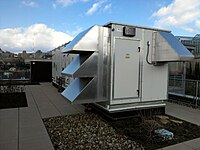
Photo from wikipedia
The energy usage intensity of healthcare institutions is extensive. The recorded relative typical energy consumption of hospitals has been noted to be in the range of 43 to 93 kWh/bed/day.… Click to show full abstract
The energy usage intensity of healthcare institutions is extensive. The recorded relative typical energy consumption of hospitals has been noted to be in the range of 43 to 93 kWh/bed/day. Currently, with the global COVID 19 pandemic, the overall energy consumption of these hospitals has proportionally increased with these higher patient occupancy rates. The demand for hot water is directly proportional to occupancy rates and contributes to a large proportion of the energy consumed. Reducing the energy and associated costs of water heating processes may prove highly beneficial to the currently severely overstrained healthcare sector. In this paper the operation of a multifarious water heating system with energy recovery was optimized in order to minimize the grid energy costs based on the ToU tariff and maximum demand charges from the utility, while the required hot water temperature was maintained. A life cycle cost analysis between two baseline systems, consisting of the multifarious water heating system with and without energy recovery was compared to the optimal control approach. The results indicate that the energy recovery system with optimal control in 5.3 years. Retrospectively, the proposed initiatives may result in a potential saving of 68.23%, over a 20 year project lifetime.
Journal Title: Journal of Energy Storage
Year Published: 2022
Link to full text (if available)
Share on Social Media: Sign Up to like & get
recommendations!